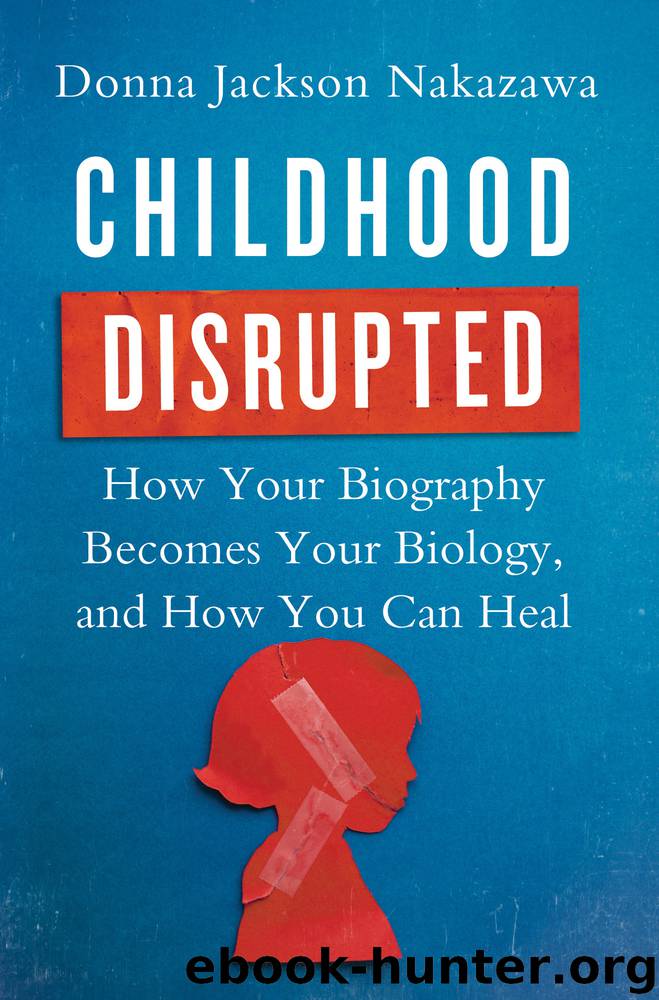Childhood Disrupted by Donna Jackson Nakazawa

Author:Donna Jackson Nakazawa
Language: eng
Format: epub
Publisher: Atria Books
Attachment to Others Is a Biological Process
Attachment occurs when infants or young children are hungry, or wet, or afraid and learn that someone cares for them and will attend to their needs. They are safe.
In most cases, when an infant’s or child’s needs are met—he is fed, his diaper is changed, his parent soothes him—he develops secure attachment, little by little, event after event. When he is regularly soothed after feeling needy or afraid, he eventually learns how to calm himself down.
The brain circuits that regulate human behavior, and give a child a sense of who he is, and that he matters—so that he forms a sense of self and a connection with other people—develop as caregivers respond to that child’s needs. These early relationships activate the growth of all the various regions of our brain that we need to use in order to have healthy relationships.
A baby smiles, a mom coos, a baby coos back, the mom smiles. In this one small moment, the mother attunes to and reflects back what her infant is expressing. And this experience—being seen and known—becomes encoded in the infant’s neural circuitry.
But if a child’s basic needs for safety and security aren’t met, she will reach adulthood without ever having learned what it means to be soothed in healthy ways—or how to calm herself down—when she meets inevitable life and relationship stressors. She will have an insecure sense of attachment.
Most psychologists agree that a child has to develop a secure attachment with at least one primary caregiver in order to learn how to effectively regulate her own emotions for the rest of her life, and in order to learn how to become attached in a healthy way in adult relationships.
Most people with attachment issues can’t understand why others are reluctant to get as close to them as they’d like; they instead feel this synaptic disconnect in the form of rejection and isolation. Think of Kat. “No relationship ever stuck for me in my twenties and early thirties, and I always thought it was the other person’s problem. It’s only now, looking back, that I realize I had this huge reactivity, and can take responsibility for how I behaved.” Kat can see now that she’d often be anxious, “a bottomless pit of need” for reassurance, then become “sarcastic or passive-aggressive if my partner wasn’t giving me enough emotional stroking.” At the same time, if someone got too close to Kat, she couldn’t sustain it. “Something small would happen in a relationship and all the sadness and fear and panic I’d felt when I was young would just come spilling out. Before I knew it, I’d be critical, blaming, controlling, and in-your-face argumentative.” Each time a relationship “imploded badly,” it reinforced Kat’s conclusions that others didn’t—and couldn’t—love her.
And so the underconnected areas of Kat’s brain stayed offline for a very long time.
As for John, psychologists would see his profound need for closeness, and his sabotaging of it, as a sign of his early insecure attachment with his dad.
Download
This site does not store any files on its server. We only index and link to content provided by other sites. Please contact the content providers to delete copyright contents if any and email us, we'll remove relevant links or contents immediately.
The Art of Thinking Clearly by Rolf Dobelli(8843)
The 5 Love Languages: The Secret to Love That Lasts by Gary Chapman(8499)
Mindhunter: Inside the FBI's Elite Serial Crime Unit by John E. Douglas & Mark Olshaker(7834)
Becoming Supernatural by Dr. Joe Dispenza(7107)
The Road Less Traveled by M. Scott Peck(6635)
Nudge - Improving Decisions about Health, Wealth, and Happiness by Thaler Sunstein(6634)
Enlightenment Now: The Case for Reason, Science, Humanism, and Progress by Steven Pinker(6407)
Win Bigly by Scott Adams(6312)
Mastermind: How to Think Like Sherlock Holmes by Maria Konnikova(6236)
The Way of Zen by Alan W. Watts(5800)
Factfulness: Ten Reasons We're Wrong About the World – and Why Things Are Better Than You Think by Hans Rosling(4022)
The State of Affairs by Esther Perel(3931)
Gerald's Game by Stephen King(3918)
Man's Search for Meaning by Viktor Frankl(3634)
The Confidence Code by Katty Kay(3566)
Thinking in Bets by Annie Duke(3533)
The Worm at the Core by Sheldon Solomon(2918)
Enlightenment Now by Steven Pinker(2917)
Liar's Poker by Michael Lewis(2812)
